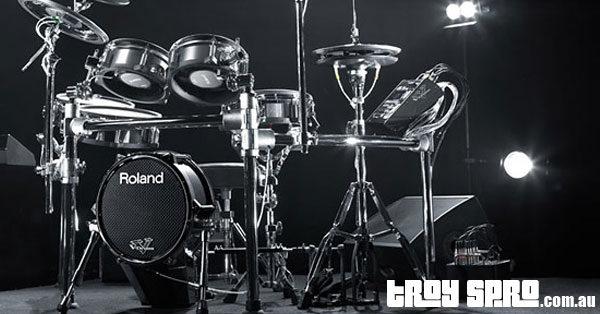In a nutshell an electronic drum kit is an electronic synthesizer that tries to mimic a normal acoustic drum kit.
There are many variations to the electronic drum kit but the usual is a set of pads mounted on hardware in exactly the same configuration as a acoustic drum kit, these pads are rubber coated and have different sensors in them that generates and electric signal when hit with a drum stick, this in turn sends a signal pulse back to the electronic module which in turn produces the selected sound for that pad.
This is an easy explanation of this as there are different qualities of pads and modules too, some pads are extremely sensitive and can get the same feel as an acoustic drum kit in regards to where you are hitting the rubber skin and how hard, some are just plain old trigger pads, one hit equals one signal equals one sound.
Here is a bit of history about the electronic drum kit for you, in 1971 it is told that the first electronic drum kit was created and used, this was apparently with the drummer of “The Moody Blues” Graeme Edge and Professor Brian Groves, the track it was used on is “Procession” which I am listening to on Myspace now while writing this.
The first commercial electronic drums were released in 1976 by Pollard Industries, this had an electronic sound generator and either one or more drum pads, this company later went bust.
Following in the footsteps of Pollard in 1978, the Simmons company was created to produce commercial electronic drum kits and bring them to the market, these were successful and a lot of high end bands and drummers used their drum kits, if you remember in the 1980’s pop video’s the hexagon shaped drum pads of the synthesizer era during that time, these were Simmons electronic drum kits.
After Simmons produced theirs, in the following years to come there were more brands to come to the market, Roland and Yamaha were during this time the big players and also bought new technology not only to the modules but also in the pads and trigger too.
There are a lot of different brands around today too, you get what you pay for also, but the above brands are still ahead of the game in regards to development and feel of the electronic drum kit.
The parts that make up an electronic drum kit are basically the same as an acoustic drum kit, the only major differences are the obvious, the pads instead of drums, wires running from the pads to the electronic sound module and the sound module, other than that they can have almost exactly the same hardware as a normal kit.
There is also stand alone units with about five to six single pads on them, like a little drum machine with pads on them, these are used to a lot these days and each pad can be assigned a sound or sample.
I’ve played acoustic kits and also an electronic drum kits over the years and also set up triggers on drum kits too, I think an electronic drum kit has its place in music, it’s good for practicing too as you don’t annoy neighbour’s when you have your head phones on and playing, also you can control volume quite well in live sound situations if playing in a band or a duo, it enables you to play quietly, the only down fall for these kits is the feel, but I think the day is coming where you won’t be able to tell on a recording if it’s a live acoustic drum kit sound or a electronic drum kit module sound.
You can buy an electronic drum kit from most music stores and their websites, also I have noticed places like JB Hi Fi popping up now with kits too, as there has been quite a few music stores and music store chains close down in the past years in Australia maybe these electronic goods stores are getting into the act of selling instruments too, we will see.
Anyway, a little look into the world of the electronic drum kit, also note, I have been given the green light to purchase a electronic drum kit when I feel like it, so, when I have a bit of spare time I’ll start looking into it, the good, the bad and the ugly, I’ll let you know, so keep an eye out.


